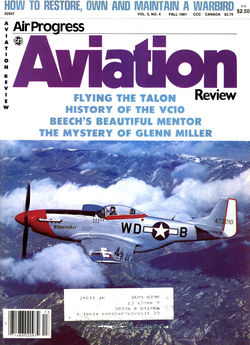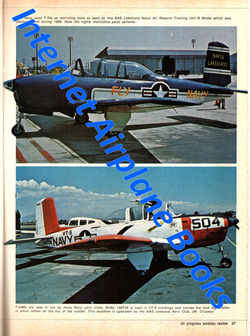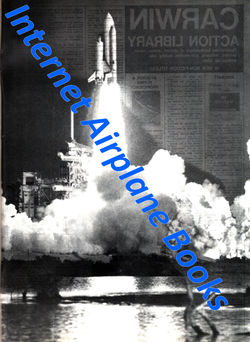AVIATION REVIEW V5 N4
VICKERS VC10_T-38_T-34 USN USAF_GLENN MILLER_RICHTHOFEN v HAWKER
AIR PROGRESS SPECIAL MAGAZINE SERIES
HOW TO RESTORE, OWN AND MAINTAIN WARBIRD – NORTH AMERICAN
P-51D MUSTANG
FLYING THE NORTHROP T-38 TALON JET TRAINER USAF
HISTORY OF THE VICKERS VC10 JET AIRLINER BOAC /
RAF TANKER
BEECH T-34 MENTOR USAF / USN VT
THE MYSTERY OF GLENN MILLER / USAAF NOORDUYN
NORSEMAN
NASA AMERICAN SPACE FLIGHT HISTORY FROM THE
MERCURY SIX TO SPACE SHUTTLE COLUMBIA
WW1 DUEL TO THE DEATH – von RICHTHOFEN &
BOELCKE / MAJOR LANOE HAWKER B.E.2
-----------------------------------------------------------------------------------------
Additional Information from Internet Encyclopedia
The Beechcraft T-34 Mentor is an American
propeller-driven, single-engined, military trainer aircraft derived from the
Beechcraft Model 35 Bonanza. The earlier versions of the T-34, dating from
around the late 1940s to the 1950s, were piston-engined. These were eventually
succeeded by the upgraded T-34C Turbo-Mentor, powered by a turboprop engine.
The T-34 remains in service more than six decades after it was first designed.
The T-34 was the brainchild of Walter Beech, who
developed it as the Beechcraft Model 45 private venture at a time when there
was no defense budget for a new trainer model. Beech hoped to sell it as an
economical alternative to the North American T-6/SNJ Texan, then in use by all
services of the U.S. military.
Three initial design concepts were developed for
the Model 45, including one with the Bonanza's signature V-tail, but the final
design that emerged in 1948 incorporated conventional tail control surfaces for
the benefit of the more conservative military[1] (featuring a relatively large
unswept vertical fin that would find its way onto the Travel Air twin-engine
civil aircraft almost ten years later). The Bonanza's fuselage with
four-passenger cabin was replaced with a narrower fuselage incorporating a
two-seater tandem cockpit and bubble canopy,[2] which provided greater
visibility for the trainee pilot and flight instructor. Structurally, the Model
45 was much stronger than the Bonanza, being designed for +10g and −4.5g, while
the Continental E-185 engine of 185 horsepower (hp) at takeoff (less than a
third of the power of the T-6's engine[3]) was the same as that fitted to
contemporary Bonanzas.
Following the prototype were three Model A45T
aircraft,[2] the first two with the same engine as the prototype and the third
with a Continental E-225,[1] which would prove to be close to the production
version. Production did not begin until 1953, when Beechcraft began delivering
T-34As to the United States Air Force (USAF) and similar Model B45 aircraft for
export. Production of the T-34B for the United States Navy (USN) began in 1955,
this version featuring a number of changes reflecting the different
requirements of the two services. The T-34B had only differential braking for
steering control on the ground instead of nosewheel steering, additional wing
dihedral and, to cater for the different heights of pilots, adjustable rudder
pedals instead of the moveable seats of the T-34A.[1] T-34A production was
completed in 1956, with T-34Bs being built until October 1957 and licensed B45
versions built in Canada (125 manufactured by Canadian Car and Foundry),[2]
Japan (173 built by Fuji Heavy Industries),[2] and Argentina (75 by FMA) until
1958. Beechcraft delivered the last Model B45s in 1959.[1] Total production of
the Continental-engined versions in the US and abroad was 1,904 aircraft.
----------------------------------------------------------------------------------------
The Vickers VC10 is a mid-sized, narrow-body
long-range British jet airliner designed and built by Vickers-Armstrongs
(Aircraft) Ltd and first flown at Brooklands, Surrey, in 1962. The airliner was
designed to operate on long-distance routes from the shorter runways of the era
and commanded excellent hot and high performance for operations from African
airports. The performance of the VC10 was such that it achieved the fastest
crossing of the Atlantic by a jet airliner, a record still held to-date for a sub-sonic
airliner, of 5 hours and 1 minute;[1][2] only the supersonic Concorde was
faster. The VC10 is often compared to the larger Soviet Ilyushin Il-62, the two
types being the only airliners to use a rear-engined quad layout; the smaller
business jet Lockheed JetStar also has this engine arrangement.
Although only a relatively small number of VC10s
were built, they provided long service with BOAC and other airlines from the
1960s to 1981. They were also used from 1965 as strategic air transports for
the Royal Air Force, and ex-passenger models and others were used as aerial
refuelling aircraft. The 50th anniversary of the first flight of the prototype
VC10, G-ARTA, was celebrated with a "VC10 Retrospective" Symposium
and the official opening of a VC10 exhibition at Brooklands Museum on 29 June
2012. The type was retired from RAF service on 20 September 2013.[3] It has
been succeeded in the aerial refuelling role by the Airbus Voyager. VC10K3
ZA147 performed the final flight of the type on 25 September 2013.
Although privately owned, Britain's aviation
industry had been government-managed in practice, particularly during the
Second World War. Design and manufacture of transport aircraft had been
abandoned to concentrate on production of combat aircraft with Britain's
transport aircraft needs being met by the provision of US aircraft through
Lend-Lease. In 1943, the Brabazon Committee introduced command economy-style
principles into the industry, specifying a number of different types of
airliners that would be required for the post-war years, though it assumed that
US dominance in transport aircraft would translate into leadership in
long-range airliners and conceded in principle that the industry might have to
cede the long-range market to US makers.
During the 1950s, the government required the
aviation industry to consolidate: in consequence only two engine makers were
left by 1959: Rolls-Royce and Bristol Siddeley. In 1960, the British Aircraft
Corporation (BAC) encompassed Vickers, Bristol and English Electric's aviation
interests, Hawker Siddeley built on de Havilland's heavy aircraft experience
and Westland consolidated helicopter manufacture.[4] The British government
also controlled route-licensing for private airlines and also oversaw the newly
established publicly owned British Overseas Airways Corporation (BOAC) long-range
and British European Airways (BEA) short and medium-range airlines.
In 1951, the Ministry of Supply asked
Vickers-Armstrongs to consider a military troop/freight development of the
Valiant V bomber with trans-Atlantic range as a successor to the de Havilland
Comet.[5] The concept interested BOAC, who entered into discussion with Vickers
and the RAF.[5] In October 1952, Vickers were contracted to build a prototype
which they designated the Type 1000 (Vickers V-1000), followed in June 1954 by
a production order for six aircraft for the RAF.[5] The planned civil airliner
was known as the VC7 (the seventh Vickers civil design).[6][7] Development was
prolonged by the need to meet the RAF's requirements for short take-off and a
self-loading capability.[6] Work started on the prototype but by 1955 the
aircraft's increased weight required a more powerful engine, causing BOAC to
question the engine development cycle. In 1955, the government cancelled the
RAF order in a round of defence cuts.[6] Vickers and the Ministry of Supply
hoped that BOAC would still be interested in the VC7 but they were reluctant to
support the production of another British aircraft following delays in the
Britannia programme and the crashes involving the de Havilland Comet.
Though BOAC had ordered modified Comet 4s, it
viewed the type as an intermediate rather than a long term type. In 1956, BOAC
ordered 15 Boeing 707s. These were oversized and underpowered for BOAC's
medium-range Empire (MRE) African and Asian routes, which involved destinations
with "hot and high" airports that reduced aircraft performance,
notably between Karachi and Singapore, and could not lift a full load from
high-altitude airports like Kano or Nairobi. Several companies proposed a
suitable replacement. De Havilland offered the DH.118, a development of the
Comet 5 project while Handley Page proposed the HP.97, based on their V bomber,
the Victor. After carefully considering the routes, Vickers offered the
VC10.[8] Crucially, Vickers was the only firm willing to launch its design as a
private venture, instead of relying on government financing.
The VC10 was a new design but used some production
ideas and techniques, as well as the Conway engines, developed for the V.1000
and VC7. It had a generous wing equipped with wide chord Fowler flaps and full
span leading edge slats for good take-off and climb performance; its rear
engines gave an efficient clean wing and reduced cabin noise.[10] The engines
were also further from the runway surface than an underwing design, an
important factor in operations from rough runways such as those common in
Africa; wide, low-pressure tyres were also adopted with this same concern in
mind.[11] The VC10 was capable of landing and taking off at slower speeds than
the rival 707 and its engines could produce considerably more thrust, providing
good 'hot and high' performance, and was considered to be a safer aircraft.
The onboard avionics and flight-deck technology
were extremely advanced, a quadruplicated automatic flight control system (a
"super autopilot") was intended to enable fully automatic
zero-visibility landings (though the autoland system did not work smoothly and
finally was removed from the Super VC10s.).[13][14] Capacity was up to 135
passengers in a two-class configuration. Vickers designer Sir George Edwards is
said to have stated that this plane was the sole viable option unless he were
to reinvent the 707 and, despite misgivings on operating cost, BOAC ordered 25
aircraft. Vickers calculated that it would need to sell 80 VC10s at about £1.75
million each to break even so, apart from BOAC's 25, another 55 remained to be
sold. Vickers offered a smaller version, the VC11, to BEA for routes like those
to Athens and Beirut but this was rejected in favour of the Hawker Siddeley
Trident.














